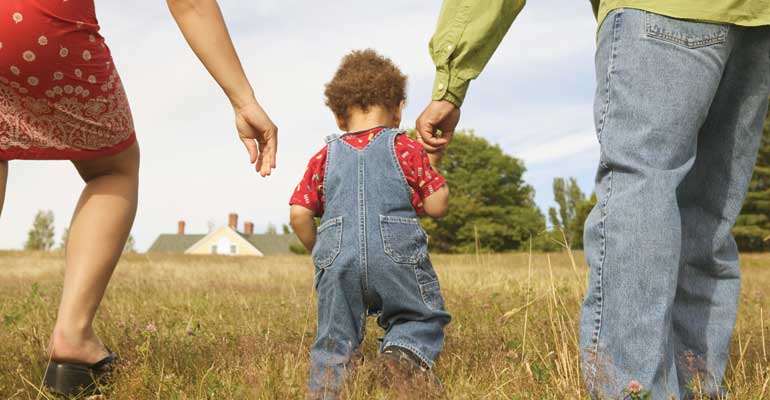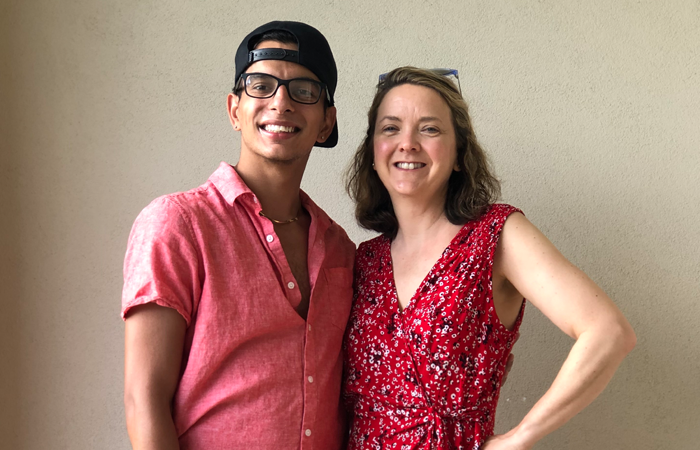My long journey’s end came 16 months after we opened the envelope containing a photo of a tiny boy, and three days after I pushed a suitcase and stroller toward airport security. Finally on my way to meet our new son, I had given a jubilant thumbs-up to my husband and daughter and waved goodbye.
The van pulled up to the orphanage just as a dozen toddlers streamed through the front door. I scanned their faces to find the one that matched the photo on my bedroom dresser. I spotted him in the arms of a young girl, who thrust him toward me. “Mama,” she said excitedly to the boy. “This is your mama.”
But the little boy for whom I’d waited so long had clearly not been waiting for me. He twisted his body away from me and hid his face in the girl’s shoulder. He was a few days shy of 18 months, old enough to know that something was up, but too young to understand what it was. That day and the next, he warily allowed me to hold him, but his small chest heaved with deep, quiet sobs. In the passport photo taken just before the ceremony that made him my son, I saw the saddest, most frightened little boy in the world.
[Free Webinar Replay: “Imagining Your Future Child”]
Adopting a Toddler: A Choice
Increasingly, adoptive parents are bringing home toddlers and older children. According to the latest government figures, 59 percent of the children adopted internationally in 2012 and 47 percent of the children adopted through the U.S. child welfare system in 2012 were between the ages of 1 through 4. The reasons vary. Some families, like mine, sign on for an infant but run into procedural delays, while others choose a country in which the process takes a year or more. Some prospective parents request a toddler because of their own ages or the ages of their other children. Some simply relish the toddler years, typically defined as 1 to 3. With their boundless curiosity and budding communication skills, toddlers radiate a sense of joy and wonder that shows us the world in a new way.
But this crucial stage in development makes it a difficult time for a child to be taken from all he knows. Lacking the cognitive and linguistic skills to understand the often-abrupt transition, most toddlers join their new families in a state of anger, fright, or grief.
“Parents experience adoption as the most joyous occasion,” says Karen Shulz, an adoption specialist at the Center for Adoption Support and Education (CASE) in Silver Spring, Maryland. “But for a toddler, it can feel like being kidnapped.”
Some children rebound quickly — within a week, my son, Julian, was gleefully running through hotel hallways and snuggling in for story time. But for many others, the adjustment takes time, attention, and parents who understand the challenge of adopting a child at this age.
[Reassuring Bedtime Stories for Toddlers]
Adopting a Toddler and Seeing Through Their Eyes
By the time a child enters toddlerhood, he has already amassed an impressive résumé and is ready to explore his world. He has begun walking and can manipulate objects. He understands what’s said to him, and answers with sounds, body language, and a few words. Still securely attached to his caregiver, he is becoming aware of himself as a separate person and is making his first stabs at independence. Over the next two years, he’ll master motor skills, string together words to express increasingly complex thoughts, and emerge as an individual.
For a toddler who is just beginning to make sense of his world, adoption changes everything, says Mary Hopkins-Best, Ed.D., author of Toddler Adoption: The Weaver’s Craft. Familiar routines disappear. The strangers who take him look and smell different. His abilities to trust and feel secure, along with his sense of control, are severely tested.
Forming a Bond
It’s hard to predict how a toddler will adjust to his new home. As a child development professional, Dr. Hopkins-Best expected adjustments when she and her husband adopted Gustavo, then 18 months old, from Peru. But even she was surprised by the strength of his reluctance to form a trusting bond. A child’s ability to bounce back from change, connect to his new family, and move ahead developmentally is influenced by many factors. Prenatal conditions, developmental delays, and temperament also affect a child’s resilience.
When Jill and Tom Brown* left their home in New York to fly to bring home 28-month-old Kamala, they felt fortunate. The little girl, known as Kam, had spent most of her life with a loving foster family, and the couple thought she would quickly and smoothly transfer her affection to them. But Kam “rejected us in the most awful way,” recalls Brown. “She would cry and scream at us to go away.” Kam refused to take any food from her new parents, and they had to ask waitresses to feed her. Miserable and insecure, the toddler slept sitting up.
[How to Strengthen Your Family…Around the Dinner Table]
“We felt so helpless,” says Brown. “Our child was grieving, and we couldn’t comfort her.” Most hurtful, she remembers, was the disappointment in Kam’s eyes when she would awaken from her nap and see the face of her new mom. As the months of grief and rejection wore on, the Browns wondered if they were the right family for Kam.
For a child who has had a secure, healthy attachment to his caregiver, grief in the weeks or months following adoption is unavoidable, says Hopkins-Best. Acknowledging his grief, holding him as he cries, and expressing empathy are important in allowing the child to begin the process of transferring attachment.
Fostering Attachment
If an adopted toddler has not experienced a secure primary attachment, his new parents can foster attachment by developing the kind of trust and dependence that are normally built in infancy. Often this means allowing — or even encouraging — a child to act younger than his years by feeding him or allowing him to sleep in his parents’ bed. Parents should make themselves known as the primary source of the child’s food and comfort on demand. Establishing routines and rituals — especially at meal- and bedtime — teaches the child that his world is predictable and safe.
Many adoption specialists believe that for attachment to occur, a child needs a consistent caregiver at home, at least for the first year or two. “It’s a hard message to give to single moms or working parents, and it’s not always feasible,” admits CASE’s Karen Shulz.
Preparing the Child
Adoption workers try to facilitate the attachment process by preparing children for their impending adoption. In domestic adoption, it’s common for adoptive parents to visit their child several times in his foster home. Social worker Nancy Ward, of the Children’s Home Society of Minnesota, in St. Paul, suggests that the new parents gradually take over the child’s care — feeding, bathing, and dressing — from the foster parents. “This way, the foster parents convey a nonverbal message to the child that ‘these people are O.K. I’m showing you that it’s safe for them to care for you.'”
International adoption doesn’t usually offer the time or the flexibility for such phasing over, but agencies suggest other strategies, such as sending a photo album in advance of the trip (see “Building Bridges” below). Before traveling to Ethiopia to adopt 23-month-old Mussie, David and Melanie Gough of Minnetrista, Minnesota, sent a photo and verbal message in a frame containing a recording device. They arrived at the children’s home to find that their child’s caretakers had used it to prepare the boy for their arrival. Although shy at first, Mussie handled the transition well and bonded quickly with his new parents.
Seeking Out Support
When Cathi and William Masilotti, of Milford, Connecticut, first met Eliza, a neglected 3-year-old living in an Illinois hotel room with her birth parents and brothers, they were pleased that she went to them so willingly. Since adopting the little girl three months ago, however, they’ve learned that she’s friendly to all strangers — a sign of attachment problems. Cathi wishes she knew other families who have adopted toddlers. “We deal with problems that parents adopting infants don’t have,” she says. “Our children come with a history, and it has an effect.” Adoption workers advise parents to initially connect with — and to stay connected to — other families who’ve done the same. Many agencies offer post-adoption services, another good source of guidance and support.
Parents are also advised to expect that the first six months may be difficult and that they’ll probably need help. Sharon Roszia, manager of the special needs adoption program at the Kinship Center, in Santa Ana, California, asks parents to gather friends and family members for a visit before their child arrives. Roszia suggests using this as an opportunity to answer questions about the adoption and then to ask what each person would be willing to do to help out. She advises families to keep a list of these offers on their refrigerator, along with professional resources and emergency numbers. Invite a friend to ask, when it’s clear that you need some assistance, “What can I do to help?”
Often parents are reluctant to admit that life with their much-longed-for child is tough or not what they had imagined. Having adopted two toddlers herself, Roszia offers some reassurance. “Recognize that this is a phase,” she says. “As you fall deeply in love with your child and you get to know each other better, the tough times will pass.”
During the difficult months with Kam, Brown might have doubted that this optimistic forecast could ever apply to her family. But recently Kam signaled an end to the months of misery they had all endured.
“Nice Mommy, nice Kam,” the 3-year-old joyfully announced. “Kam no angry any more. Kam happy now.”
*Names have been changed to protect privacy.


